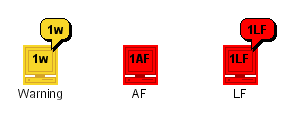JViews TGO provides a
predefined trap system, which modifies the graphical representation
of telecom objects according to the traps present in the objects.
The Trap dictionary can be used to complement the information of
the SNMP state dictionary. See Trap states in the Business
Objects and Data Sources documentation for more information.
Trap conditions
You can use trap conditions to customize
the graphic representation of your objects through cascading
styles sheets.
In CSS selectors, new and acknowledged traps are identified by
the attribute name ("
objectState
"), the trap type, and the information indicating whether it is a
new or an acknowledged trap.
The following selector matches all objects
that have new link failure traps.
object."ilog.tgo.model.IltObject"["objectState.Trap.LinkFailure.New"] {
...
}
The following selector matches all objects
that have acknowledged link failure traps.
object."ilog.tgo.model.IltObject"["objectState.Trap.LinkFailure.Acknowledged" {
...
}
How to change the object representation based on traps
The following CSS extract customizes the
graphic representation of business objects according to the value
of traps set in the object. In this configuration, the alarm
balloon decoration is hidden for all business objects that use
the SNMP object state, except those that have new traps of type
LinkFailure.
object."ilog.tgo.model.IltObject"["objectState.SNMP.State"] {
alarmBalloonVisible: false;
}
object."ilog.tgo.model.IltObject"["objectState.Trap.LinkFailure.New"] {
alarmBalloonVisible: true;
}
The following figure illustrates this
configuration.

Trap state styling example